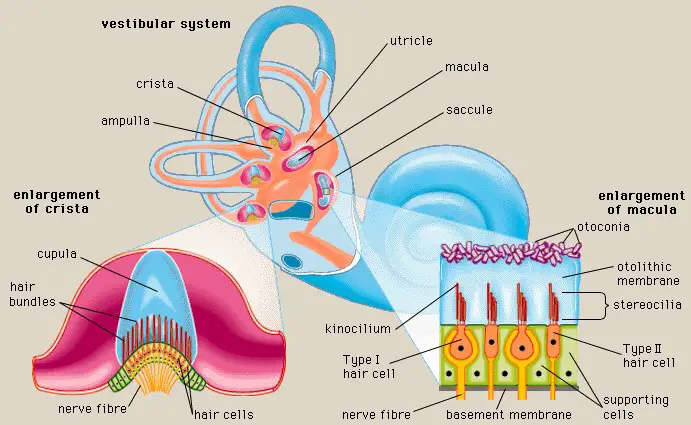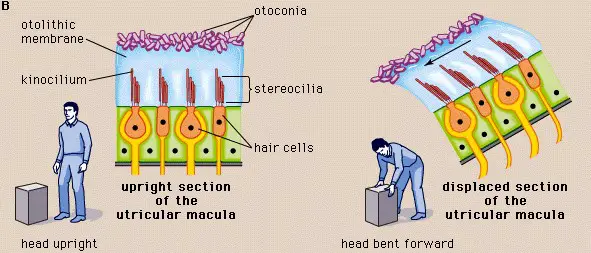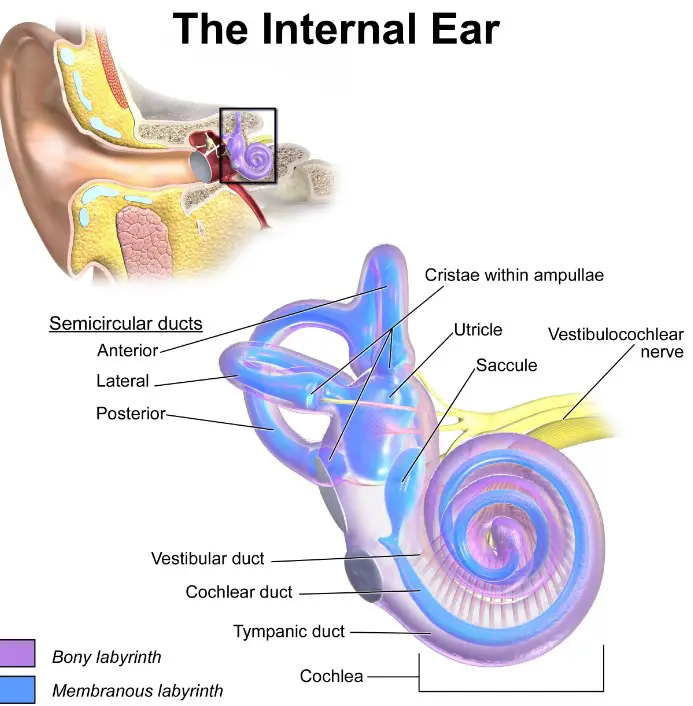The inner ear is a complex labyrinth, not just for sound transmission but also a crucial player in our sense of balance and spatial orientation. Among its lesser-known components are the utricle and saccule, integral to the vestibular system that helps us navigate the world without losing our footing. While not as widely recognized as the cochlea, these structures hold the key to understanding how we maintain equilibrium and perceive motion and gravity.
The utricle and saccule are two distinct structures located within the vestibular system of the inner ear, functioning primarily to detect linear acceleration and head position relative to gravity. The utricle is responsible for sensing horizontal movements, whereas the saccule detects vertical accelerations. Together, they provide critical information to the brain about our body’s orientation, ensuring we can walk, run, and move smoothly through our environments.
Diving deeper into these structures reveals their fascinating anatomy and function. The utricle and saccule are filled with a gel-like substance and lined with hair cells, which are displaced by movements of otoliths—tiny calcium carbonate crystals—allowing us to perceive direction and speed of motion. This sophisticated system underscores the complexity of human balance and orientation, highlighting the marvels of our sensory capabilities and the precision with which our bodies navigate the physical world.

Inner Ear Overview
Anatomy
The inner ear, also known as the labyrinth, comprises two main structures: the cochlea, responsible for hearing, and the vestibular system, which aids in balance. This intricate system is encased in the temporal bone of the skull, making it both protected and uniquely positioned to perform its functions effectively. It consists of three semicircular canals, the vestibule (housing the utricle and saccule), and the connecting cochlear duct.
Function
The primary function of the inner ear extends beyond hearing to include the critical role of maintaining balance and spatial orientation. The cochlea converts sound waves into nerve impulses, which are then interpreted by the brain as sound. Meanwhile, the vestibular system sends information to the brain about head position and motion, helping to keep us upright and navigate our environment with precision.
Vestibular System Basics
The vestibular system is a complex network that provides the leading edge in our ability to maintain balance and posture, navigate space, and coordinate head and eye movements.
Role in Balance
Balance is a complex process that relies on the integration of various sensory information by the brain, including visual input, proprioceptive (body position) information, and vestibular signals from the inner ear. The vestibular system’s role in this process is to detect changes in head position and motion, contributing to our sense of equilibrium.
Components
The vestibular system consists of the three semicircular canals, which detect rotational movements, and the otolith organs—the utricle and saccule—that sense linear accelerations. Together, these components provide comprehensive coverage of all possible head movements and orientations relative to gravity.
Utricle Explained
Location and Structure
The utricle is one of the two otolith organs located in the vestibule of the inner ear. Shaped somewhat like an oval pouch, it contains a macula, an area densely packed with hair cells, and otoliths, tiny calcium carbonate crystals. These components are key to the utricle’s ability to sense movement.
Function
The utricle’s primary function is to detect linear movements of the head along the horizontal plane. This includes forward-backward and side-to-side motions. By sensing these movements, the utricle helps maintain balance, especially during walking or quick changes in direction.
Sensory Mechanism
The utricle’s sensory mechanism involves the displacement of otoliths that sit atop the hair cells within the macula. When the head moves, these crystals shift, causing the hair cells to bend. This bending alters the rate of nerve impulses sent to the brain, informing it of the head’s movement and orientation.
Saccule Uncovered
Location and Structure
Positioned adjacent to the utricle, the saccule is the second otolith organ in the vestibular system. It also contains a macula with hair cells and otoliths but is oriented vertically, making its structure and function complementary to that of the utricle.
Function
The saccule’s main role is to detect linear accelerations and head positions relative to gravity but in the vertical plane. This includes sensing upward and downward movements, such as when jumping or riding in an elevator, contributing significantly to our vertical spatial awareness.
Sensory Mechanism
Similar to the utricle, the saccule’s sensory mechanism is driven by the movement of otoliths over the hair cells. Vertical movements or changes in head position cause these crystals to shift, bending the hair cells, and altering the electrical signals sent to the brain. This process allows the brain to interpret vertical movements accurately, aiding in balance and orientation.

Comparing Utricle and Saccule
Understanding the utricle and saccule involves recognizing their unique characteristics and contributions to the vestibular system. While both play pivotal roles in balance and spatial orientation, their distinct structures and functions cater to different aspects of these processes.
Physical Differences
The utricle and saccule differ primarily in their orientation within the vestibular system. The utricle is positioned horizontally, making it more sensitive to horizontal movements, such as walking or sliding. In contrast, the saccule stands vertically, aligning it with the detection of vertical motions, like jumping or ascending in an elevator. This orientation impacts not only their function but also the type of sensory input they process.
Functional Variances
These physical differences lead to functional variances between the two. The utricle’s horizontal alignment allows it to effectively monitor linear accelerations and head tilts in the horizontal plane, providing key information for maintaining balance during lateral movements. Conversely, the saccule’s vertical positioning makes it adept at detecting vertical accelerations and changes in head position relative to gravity, crucial for vertical balance control.
Sensory Input Processing
Both the utricle and saccule use a similar sensory mechanism to process input: the movement of otoliths across hair cells, triggering nerve impulses sent to the brain. However, because of their distinct orientations, they respond to different directions of force. This complementary functioning ensures a full range of motion detection, from the simplest tilt of the head to complex navigations through space.
Significance in Balance and Orientation
The combined efforts of the utricle and saccule are fundamental to our ability to perceive our position and movement within our environment, maintaining our balance and orientation.
Contribution to Equilibrium
Equilibrium is not just about standing upright; it’s about maintaining a controlled position throughout all activities, whether static or dynamic. The utricle and saccule’s input is crucial for the brain to understand the body’s orientation and adjust muscle actions accordingly, preventing falls and ensuring smooth, coordinated movement.
Interaction with Other Sensory Systems
The vestibular system does not work in isolation. Its effectiveness lies in its ability to integrate information from the visual system and proprioception (the sense of body position). This multisensory integration ensures that balance is maintained not just based on the internal sense of movement but also in response to the external environment.
Clinical Implications
Disruptions to the utricle and saccule can lead to significant balance disorders and dizziness, affecting a person’s quality of life. Understanding the clinical implications of such disruptions is key to diagnosing and managing these conditions.
Disorders Affecting Utricle and Saccule
Several conditions can impair the functioning of the utricle and saccule, including vestibular neuritis, Meniere’s disease, and benign paroxysmal positional vertigo (BPPV). Each of these conditions affects balance and spatial orientation in distinct ways, often leading to symptoms like vertigo, dizziness, and imbalance.
Diagnostic Approaches
Diagnosing disorders related to the utricle and saccule involves a series of tests designed to evaluate the vestibular system’s functioning. These can include balance tests, vestibular evoked myogenic potentials (VEMP) testing, and videonystagmography (VNG), which assess the body’s response to various stimuli and movements, pinpointing any abnormalities in vestibular processing.
Treatment and Management
Treatment options vary depending on the specific disorder but may involve:
- Vestibular rehabilitation therapy (VRT): A form of physical therapy aimed at restoring vestibular function and improving balance.
- Medication: To manage symptoms like nausea or vertigo.
- Surgical interventions: In severe cases, to correct underlying issues within the vestibular system.
Managing vestibular disorders requires a comprehensive approach, often involving a team of specialists to address the physical, emotional, and functional impacts of these conditions.
Frequently Asked Questions
How do the utricle and saccule affect balance?
The utricle and saccule play pivotal roles in maintaining balance by sensing linear accelerations and changes in head position relative to gravity. They send signals to the brain about our movements and orientation, helping to coordinate balance and eye movements, ensuring stability and precise navigation in our environment.
Can problems with the utricle and saccule lead to dizziness?
Yes, issues with the utricle and saccule can lead to dizziness and balance disorders. As they are key to detecting motion and orienting us in space, any dysfunction can result in vertigo, imbalance, and a distorted sense of motion, significantly affecting one’s quality of life.
What distinguishes the utricle from the saccule?
The primary distinction between the utricle and saccule lies in their orientation and function. The utricle is sensitive to horizontal movements, such as walking or running on a flat surface, while the saccule responds to vertical accelerations, like going up or down in an elevator. This differentiation allows the body to accurately interpret various movements and gravitational signals.
How are the utricle and saccule diagnosed and treated?
Diagnosing issues with the utricle and saccule typically involves vestibular testing procedures that assess balance and eye movements in response to various stimuli. Treatment depends on the underlying condition but may include vestibular rehabilitation, medications for symptoms like vertigo, or, in rare cases, surgery to correct vestibular disorders.
Conclusion
The exploration of the utricle and saccule unveils the intricacies of the human vestibular system and its indispensable role in maintaining balance and spatial orientation. By understanding how these structures function in harmony to interpret movements and gravitational forces, we gain insight into the body’s remarkable ability to navigate and interact with the world.
Reflecting on the clinical significance of the utricle and saccule highlights the importance of diagnosing and treating vestibular disorders effectively. As we continue to unravel the mysteries of the inner ear, the knowledge gained not only advances medical science but also improves the lives of those affected by balance disorders, ensuring they can move through life with confidence and stability.

